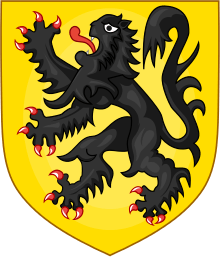Baldwin III, Count of Flanders
| Baldwin III, Count of Flanders | |
|---|---|
 Arms of the counts of Flanders | |
| Spouse(s) | Mathilde of Saxony |
|
Issue | |
| Noble family | House of Flanders |
| Father | Arnulf I of Flanders |
| Mother | Adele of Vermandois |
| Born | c. 940 |
| Died | 962 |
Baldwin III The Young of Flanders (c. 940–962) was Count of Flanders, who briefly ruled the County of Flanders (an area that is now northwestern Belgium and southwestern Netherlands), together with his father Arnulf I (c. 890 – 965).
Biography
Baldwin III was born c. 940, as the son of Arnulf I, Count of Flanders and his second wife, Adele of Vermandois (c. 915 – 969), daughter of Herbert II, Count of Vermandois.[1] His father, Arnulf I had made Baldwin co-ruler in 958, but Baldwin died before his father and was succeeded by his infant son Arnulf II,[1] with Arnulf I acting as regent until his own death. Then Baldwin Balso continued as the regent for the child.
During his short rule, Baldwin was responsible for establishing the wool manufacturing industry at Ghent and markets at other towns in Flanders.[2] Baldwin III died on 1 January 962.[1] After Baldwin's death, Arnulf I arranged for King Lothair of France to become the guardian of Baldwin's son Arnulf II.[3]
Marriage and issue
"Shortly before 961" Baldwin married Mathilde of Saxony († 1008), daughter of Hermann Billung(† 973), Duke of Saxony.[4] They had a son, Baldwin's heir:
- Arnulf II, Count of Flanders (c. 960 – 987), who succeeded as count.[1] He married Rozala of Lombardy and had issue, Baldwin IV of Flanders and Matilda.
Ancestry
| Ancestors of Baldwin III, Count of Flanders | |||||||||||||||||||||||||||||||||||||||||||||||||||||||||||||||||||||||||||||||||||||||||||||||||||||||||||||||||||||||||||||||||||||||||||||||||||||||||||||||||||||||||||||||||||||||||||||||||||||||||||||||||||||||||||||||||||||||||||||||||||||||||||||||||||||||||||||||||||||||||||||||||||||||||||||||||||||||||||||||||||||||||||||||||||||||||||||||||||||||||||||||||||||||||||||||||||||||||||||||||||||||||||||||||||||||||||||||||||||||||||||||||||||||||||
|---|---|---|---|---|---|---|---|---|---|---|---|---|---|---|---|---|---|---|---|---|---|---|---|---|---|---|---|---|---|---|---|---|---|---|---|---|---|---|---|---|---|---|---|---|---|---|---|---|---|---|---|---|---|---|---|---|---|---|---|---|---|---|---|---|---|---|---|---|---|---|---|---|---|---|---|---|---|---|---|---|---|---|---|---|---|---|---|---|---|---|---|---|---|---|---|---|---|---|---|---|---|---|---|---|---|---|---|---|---|---|---|---|---|---|---|---|---|---|---|---|---|---|---|---|---|---|---|---|---|---|---|---|---|---|---|---|---|---|---|---|---|---|---|---|---|---|---|---|---|---|---|---|---|---|---|---|---|---|---|---|---|---|---|---|---|---|---|---|---|---|---|---|---|---|---|---|---|---|---|---|---|---|---|---|---|---|---|---|---|---|---|---|---|---|---|---|---|---|---|---|---|---|---|---|---|---|---|---|---|---|---|---|---|---|---|---|---|---|---|---|---|---|---|---|---|---|---|---|---|---|---|---|---|---|---|---|---|---|---|---|---|---|---|---|---|---|---|---|---|---|---|---|---|---|---|---|---|---|---|---|---|---|---|---|---|---|---|---|---|---|---|---|---|---|---|---|---|---|---|---|---|---|---|---|---|---|---|---|---|---|---|---|---|---|---|---|---|---|---|---|---|---|---|---|---|---|---|---|---|---|---|---|---|---|---|---|---|---|---|---|---|---|---|---|---|---|---|---|---|---|---|---|---|---|---|---|---|---|---|---|---|---|---|---|---|---|---|---|---|---|---|---|---|---|---|---|---|---|---|---|---|---|---|---|---|---|---|---|---|---|---|---|---|---|---|---|---|---|---|---|---|---|---|---|---|---|---|---|---|---|---|---|---|---|---|---|---|---|---|---|---|---|---|---|---|---|---|---|---|---|---|---|---|---|---|---|---|---|---|---|---|---|---|---|---|---|---|---|---|---|---|---|---|---|---|---|---|---|---|---|---|---|---|---|---|---|---|---|---|---|---|---|---|---|---|---|---|---|---|
| |||||||||||||||||||||||||||||||||||||||||||||||||||||||||||||||||||||||||||||||||||||||||||||||||||||||||||||||||||||||||||||||||||||||||||||||||||||||||||||||||||||||||||||||||||||||||||||||||||||||||||||||||||||||||||||||||||||||||||||||||||||||||||||||||||||||||||||||||||||||||||||||||||||||||||||||||||||||||||||||||||||||||||||||||||||||||||||||||||||||||||||||||||||||||||||||||||||||||||||||||||||||||||||||||||||||||||||||||||||||||||||||||||||||||||
See also
References
- 1 2 3 4 Detlev Schwennicke, Europäische Stammtafeln: Stammtafeln zur Geschichte der Europäischen Staaten, Neue Folge, Band II (Verlag von J. A. Stargardt, Marburg, Germany, 1984), Tafel 5
- ↑ Tracy Borman, Queen of the Conqueror: The Life of Matilda, Wife of William I (Bantam Books, New York, 2011), p. 3
- ↑ The Annals of Flodoard of Reims, 916-966, Ed. & Trans. Steven Fanning & Bernard S. Bachrach (University of Toronto Press, CA, 2004) 44F & n. 219
- ↑ Detlev Schwennicke, Europäische Stammtafeln: Stammtafeln zur Geschichte der Europäischen Staaten, Neue Folge, Band I (Verlag von J. A. Stargardt, Marburg, Germany, 1980), Tafel 8
Notes
| Preceded by Arnulf I |
958–962 with Arnulf I |
Succeeded by Arnulf II |